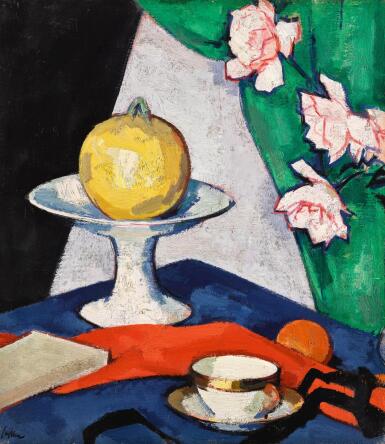
SAMUEL JOHN PEPLOE, R.S.A. | STILL LIFE WITH ROSES (RECTO); STILL LIFE WITH TEAPOT AND FRUIT (VERSO)
Auction Closed
September 18, 02:04 PM GMT
Estimate
150,000 - 200,000 GBP
Lot Details
Description
SAMUEL JOHN PEPLOE, R.S.A.
1871-1935
STILL LIFE WITH ROSES (RECTO); STILL LIFE WITH TEAPOT AND FRUIT (VERSO)
signed l.l.: Peploe
oil on canvas
46 by 40.5cm., 18 by 16in.
James McClure and Son, Glasgow;
Edmiston's, Glasgow, purchased circa 1969 and thence by descent;
Bonhams, Edinburgh, 31 August 2011, lot 136, where purchased by the present owner
Painted circa 1920 Still Life with Roses demonstrates Peploe's fascination with the floral still life as well as shape and form, colour and tone. Indeed, Peploe himself stated 'There is so much in mere objects, flowers, leaves, jugs, what not - colours, forms, relation - I can never see the mystery coming to an end.' (letter written by Peploe, quoted in, S. Cursiter, Peploe; An Intimate Memoir of an Artist and His Work, 1947, p.73). The spherical melon painted with thick confident brushstrokes sits just off-centre, whilst planes of strong primary colour create a dynamic contrast. The pink roses are dramatically cropped and thrown into relief against the green drapery behind. The cup and saucer in the foreground are exactingly studied and contrast strikingly with the angular table top.
For Peploe, the execution of the perfect still life was an obsession that dominated his career. It was both an aesthetic and intellectual excerise with each element carefully considered before brush was ever put to canvas. Indeed, in his biography of the artist Stanley Curister, P.R.S.A., noted that, 'when Peploe selected his fruit or flowers from a painter's point of view he presented a new problem to the Edinburgh florists or grocers. They did not always understand when he rejected a lemon, for its form, or a pear for its colour, and he remained unmoved by the protestations of ripeness of flavour' (ibid, p.55).
The work on the reverse of the canvas, a still life of a teapot and fruit, was painted circa 1913 and shows the dramatic influence of Cézanne on Peploe’s artistic development. The composition is thoroughly modern and relates to similar transitional pictures such as the highly significant work Still Life (1913, Scottish National Gallery of Modern Art, Edinburgh).
